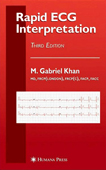The ECG is the oldest cardiologic test, but even 100 years after its inception, it continues as the most commonly used
cardiologic test. Despite the advent of expensive and sophisticated alternatives, the ECG remains the most reliable
tool for the conÞrmation of acute myocardial infarction (MI). The ECG -- not the CK-MB, troponins, echocardiogram, or
SPECT or PET scan -- dictates the timely administration of lifesaving PCI or thrombolytic therapy. There is no test to
rival the ECG in the diagnosis of arrhythmias, which is a common and bothersome clinical cardiologic problem. In this
new third edition, Rapid ECG Interpretation presents a systematic step-by-step approach that provides protocols
consistent with changes in cardiology practice over the past decade. All diagnostic ECG criteria are given with
relevant and instructive ECGs, providing a quick review or refresher for proficiency tests and for physicians preparing
for the ECG section of the Cardiovascular Diseases Board Examination. Among the additions to this new edition is a new
chapter, ECG Board Assessment Quiz, whichh provides 81 selected ECG tracings which should sharpen the skills of all who
which to Interpret ECGs.
Authoratative and timely, Rapid ECG Interpretation, Third Edition, is an essestial reference for cardiologists,
cardiology fellows, internists, residents in internal medicine, family practicioners, and residents in family practice.
1 Basic Concepts 1
2 Step-by-Step Method for Accurate ECG Interpretation 25
3 The P Wave 89
4 Bundle Branch Block 95
5 ST Segment Abnormalities 117
6 Q Wave Abnormalities 147
7 Atrial and Ventricular Hypertrophy 191
8 T Waves 205
9 Electrical Axis and Fascicular Block 223
10 Miscellaneous Conditions 237
11 Arrhythmias 267


